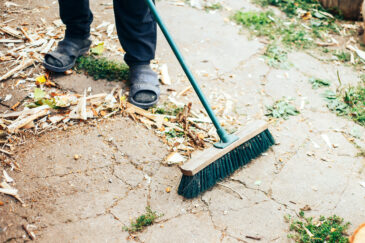 Recently, I watched a relatively brief documentary story on Texas Country Reporter about Nam Joti Kaur Khalsa, a broom maker in Austin, TX who creates brooms by hand. She espoused a philosophy about the importance of using a broom to “clean up” both physical and psychological spaces. She captured something ancient and profound. She embraced the broom as a tool of renewal, ritual, and mindfulness, not just maintenance.
Recently, I watched a relatively brief documentary story on Texas Country Reporter about Nam Joti Kaur Khalsa, a broom maker in Austin, TX who creates brooms by hand. She espoused a philosophy about the importance of using a broom to “clean up” both physical and psychological spaces. She captured something ancient and profound. She embraced the broom as a tool of renewal, ritual, and mindfulness, not just maintenance.
Across cultures, brooms have always represented purification, transition, and readiness for renewal. In many traditions ranging from Appalachian folklore to Japanese New Year rituals, sweeping is an act of clearing out old energy to make space for the new. The Austin craftswoman, by hand-making brooms and encouraging people to use them with intention, reconnects us to that lineage. She’s not selling cleaning tools. She’s offering a philosophy of presence and restoration. Each sweep becomes a statement. We should be sweeping away what no longer serves us either physically, emotionally, or spiritually.
In healthcare, especially in leadership, the metaphor of “sweeping” is incredibly resonant. Healthcare leaders are surrounded by regulatory debris, legacy systems, and overlapping priorities. The “broom” reminds us to pause and clear the floor. We should strive to simplify, prioritize, and make room for healing work to happen.
The psychological residue of burnout, stress, and conflict accumulates just like dust. Leaders can set an example by addressing it openly through reflection, listening sessions, and acts of gratitude that “sweep away” tension. Kindness is also critical. We must treat our coworkers and providers the way we care for our patients and their families.
A “clean sweep” in healthcare does not mean erasing but honoring the past. We should, as a team with intention, decide what traditions, tools, and attitudes to carry forward and which to leave in the past. The broom’s bristles move outward in every direction, symbolizing the reach of leadership that touches every corner of an organization.
Imagine a CIO or CNO literally holding a handcrafted (or machine manufactured) broom as a storytelling device in a leadership retreat or at an all-employee meeting. It could serve as a visual reminder that transformation begins with clearing space.
In healthcare, emotional debris builds up quickly in the form of stress, grief, frustration, and fatigue. If not swept regularly, it settles into the corners of our culture and erodes morale. The Austin broom maker reminds us that sweeping can be a restorative ritual. When leaders take time to clear their own minds, to reflect, or to reconnect with purpose, they set a quiet example for their teams. Sometimes the most effective leadership isn’t about adding more. It’s about removing what no longer belongs. It’s also about being realistic about what can and should be done.
During my long career as a healthcare CIO, I consistently reminded my employees and our coworkers that “We can do anything, but we can’t do everything.” Fewer meetings, shorter emails, simpler workflows, cleaner priorities, and less ambiguity make a difference.
On a personal level, sweeping our very long family driveway is something my father assigned me on a regular basis when I was just 10 years old. Eventually, as a major surprise to me, I learned to enjoy it. Now, though I have purchased a leaf blower, I still enjoy sweeping our 2-car garage and its street-level approach. Though I didn’t think about it until the Texas Country Reporter story, I realize now that it’s a mindful ritual with a quick and easily observable outcome.
When I pick up a broom, I feel like I’m grounding myself in the present. I’m very much aware of my environment. I’m creating order while practicing care. It’s a humble and profound act of control amid chaos. Anyone who works in either healthcare or IT or at the nexus of healthcare and IT (HIT) understands chaos. In my home, whether vacuuming or sweeping together, whether cleaning a porch, a garage, or a shared living space is a symbol of shared renewal.
After reading this blog prior to publishing, my wife reminded me about how I reacted the morning after a Category 3 tornado hit our Dallas, TX neighborhood, including our home where we huddled for safety in a windowless hallway while the tornado passed over. Fortunately, no one in the miles long path of the tornado was seriously injured, but our neighborhood was devastated – magnificent trees down, beautiful houses destroyed, and power gone. The next morning, to deal with the overwhelming destruction and probably in a state of mild shock and disbelief, I opened the garage door manually, grabbed a broom and (in my robe and sandals) spent 3 hours sweeping away all the debris in the driveway. It was my first step in reestablishing normalcy, an unconscious act that helped ground me.
The metaphor works on both family and non-family relationships. Sweeping should be done with old arguments, expectations, or clutter. It makes sense to periodically “sweep away” misunderstandings, clear away assumptions, and start fresh to make room for expanded and unhurried conversations and to increase empathy.
In every area, from the hospital floor to the living room floor sweeping is both practical and sacred. It’s the pause between endings and beginnings. It’s how we reclaim focus, honor what’s worth keeping, and prepare for what’s next. “When you make a clean sweep,” the Austin broom maker said, “you’re not just tidying up. You’re starting over, with purpose.” Maybe that’s the quiet wisdom our families, our industry, and our world, need right now.
